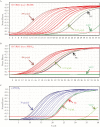High-Sensitivity Assays for Plasmodium falciparum Infection by Immuno-Polymerase Chain Reaction Detection of PfIDEh and PfLDH Antigens
- PMID: 28934434
- PMCID: PMC5854022
- DOI: 10.1093/infdis/jix369
High-Sensitivity Assays for Plasmodium falciparum Infection by Immuno-Polymerase Chain Reaction Detection of PfIDEh and PfLDH Antigens
Abstract
Background: Rapid diagnostic tests based on Plasmodium falciparum histidine-rich protein II (PfHRP-II) and P. falciparum lactate dehydrogenase (PfLDH) antigens are widely deployed for detection of P. falciparum infection; however, these tests often miss cases of low-level parasitemia, and PfHRP-II tests can give false-negative results when P. falciparum strains do not express this antigen.
Methods: We screened proteomic data for highly expressed P. falciparum proteins and compared their features to those of PfHRP-II and PfLDH biomarkers. Search criteria included high levels of expression, conservation in all parasite strains, and good correlation of antigen levels with parasitemia and its clearance after drug treatment. Different assay methods were compared for sensitive detection of parasitemia in P. falciparum cultures.
Results: Among potential new biomarkers, a P. falciparum homolog of insulin-degrading enzyme (PfIDEh) met our search criteria. Comparative enzyme-linked immunosorbent assays with monoclonal antibodies against PfLDH or PfIDEh showed detection limits of 100-200 parasites/µL and 200-400 parasites/µL, respectively. Detection was dramatically improved by use of real-time immuno-polymerase chain reaction (PCR), to parasitemia limits of 0.02 parasite/µL and 0.78 parasite/µL in PfLDH- and PfIDEh-based assays, respectively.
Conclusions: The ability of PfLDH- or PfIDEh-based immuno-PCR assays to detect <1 parasite/µL suggests that improvements of bound antibody sensor technology may greatly increase the sensitivity of malaria rapid diagnostic tests.
Keywords: PfHRP-II; enzyme-linked immunosorbent assay; immuno-PCR; insulin-degrading enzyme; lactate dehydrogenase enzyme.
Published by Oxford University Press for the Infectious Diseases Society of America 2017. This work is written by (a) US Government employee(s) and is in the public domain in the US.
Figures




Similar articles
-
Performance of coumarin-derived dendrimer-based fluorescence-linked immunosorbent assay (FLISA) to detect malaria antigen.Malar J. 2014 Jul 10;13:266. doi: 10.1186/1475-2875-13-266. Malar J. 2014. PMID: 25011624 Free PMC article.
-
Detection of histidine rich protein & lactate dehydrogenase of Plasmodium falciparum in malaria patients by sandwich ELISA using in-house reagents.Indian J Med Res. 2013 Dec;138(6):977-87. Indian J Med Res. 2013. PMID: 24521645 Free PMC article.
-
Unclear association between levels of Plasmodium falciparum lactate dehydrogenase (PfLDH) in saliva of malaria patients and blood parasitaemia: diagnostic implications?Malar J. 2018 Jan 5;17(1):9. doi: 10.1186/s12936-017-2151-y. Malar J. 2018. PMID: 29304786 Free PMC article.
-
Microfluidic device: A versatile biosensor platform to multiplex aptamer-based detection of malaria biomarkers.Cell Biochem Funct. 2024 Aug;42(6):e4104. doi: 10.1002/cbf.4104. Cell Biochem Funct. 2024. PMID: 39118353 Review.
-
A review of practical techniques for the diagnosis of malaria.Ann Trop Med Parasitol. 1998 Jun;92(4):419-33. doi: 10.1080/00034989859401. Ann Trop Med Parasitol. 1998. PMID: 9683894 Review.
Cited by
-
Template copy number and the sensitivity of quantitative PCR for Plasmodium falciparum in asymptomatic individuals.Malar J. 2020 Aug 18;19(1):295. doi: 10.1186/s12936-020-03365-8. Malar J. 2020. PMID: 32811534 Free PMC article.
-
Laboratory Detection of Malaria Antigens: a Strong Tool for Malaria Research, Diagnosis, and Epidemiology.Clin Microbiol Rev. 2021 Jun 16;34(3):e0025020. doi: 10.1128/CMR.00250-20. Epub 2021 May 26. Clin Microbiol Rev. 2021. PMID: 34043447 Free PMC article.
-
Is Immuno-PCR Better than ELISA Test for Detection of Toxoplasma gondii IgG Antibody?Acta Parasitol. 2022 Jun;67(2):904-911. doi: 10.1007/s11686-022-00537-1. Epub 2022 Mar 24. Acta Parasitol. 2022. PMID: 35332384 Free PMC article.
-
A Dual, Systematic Approach to Malaria Diagnostic Biomarker Discovery.Clin Infect Dis. 2022 Jan 7;74(1):40-51. doi: 10.1093/cid/ciab251. Clin Infect Dis. 2022. PMID: 34718455 Free PMC article.
-
Sensitive Immunoassay Detection of Plasmodium Lactate Dehydrogenase by Inductively Coupled Plasma Mass Spectrometry.Front Cell Infect Microbiol. 2021 Jan 11;10:620419. doi: 10.3389/fcimb.2020.620419. eCollection 2020. Front Cell Infect Microbiol. 2021. PMID: 33505925 Free PMC article.
References
-
- World Health Organization Global Malaria Programme. World malaria report. Available at: http://www.who.int/malaria/publications/world-malaria-report-2016/en/. Accessed 24 August 2017.
-
- Slater HC, Ross A, Ouédraogo AL et al. . Assessing the impact of next-generation rapid diagnostic tests on Plasmodium falciparum malaria elimination strategies. Nature 2015; 528:S94–101. - PubMed
-
- Wu L, van den Hoogen LL, Slater H et al. . Comparison of diagnostics for the detection of asymptomatic Plasmodium falciparum infections to inform control and elimination strategies. Nature 2015; 528:S86–93. - PubMed
Publication types
MeSH terms
Substances
LinkOut - more resources
Full Text Sources
Other Literature Sources
Miscellaneous

